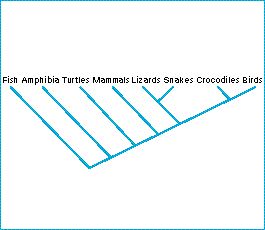Cladism

Cladism is one of the three main taxonomic schools and is rigorously based upon the phylogenetic principle as a means of biological classification. This means that the cladist’s method is evolutionary: species are grouped according to how recently they share a common ancestor.
• Sister species When a species splits during evolution it will usually form two descendant species, called sister species, and in a cladistic classification sister species are grouped together. Cladists therefore ignore phenetic similarities in organisms and attempt to uncover phylogenetic relationships by means of shared derived characters. As a result, they only recognize monophyletic groups. Paraphyletic and polyphyletic groups are excluded.
• Branching hierachies In classifying species by phylogenetic relationships, a branching hierarchy of ancestral relations is created. This hierarchy exists independently of the methods used to discover it and is unambiguous in form. In contrast to classifying by the phenetic principle, cladists have an objective reference point against which to test their classifications.
Figure: a classification of the main vertebrate groups on the cladistic principle, mirrors their phylogenetic history.
| Next |



